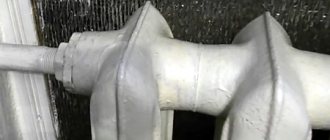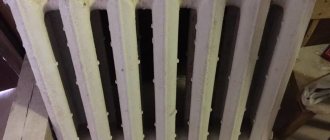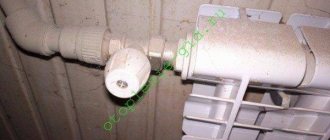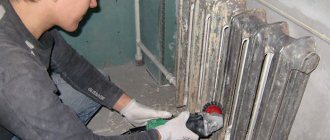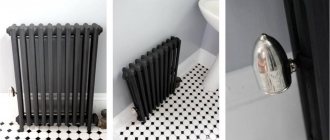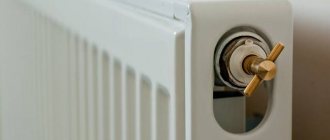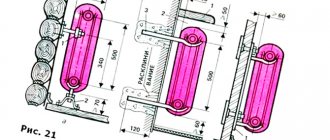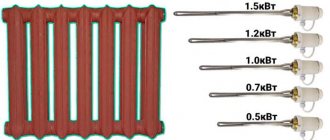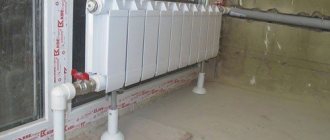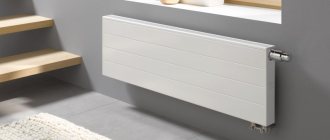Over time, any radiator will heat your living space worse and worse. The reason for this is its gradual contamination from the inside. It is also greatly facilitated by the coolant, which, when circulating through the general system, brings “foreign” contaminants into your radiator. How to flush a heating battery to return it to its previous useful volume of heat? We will tell you about the features of both external and internal cleaning.
For what?
Let's decide why we need to spend time and effort cleaning the radiator. Flushing is necessary in the following cases:
- During a tactile examination, you determined that the battery is heating unevenly - one part is colder than the other.
- Compared to other seasons, your apartment has warmed up an order of magnitude slower (especially if your neighbors don’t notice this in their homes).
- The heating main is hotter than the radiators.
- For private houses, energy resources for heating have increased, but heat transfer has remained the same or even decreased.
The bimetallic radiator takes the lead today.
Thus, without cleaning, your house will become colder and colder every season, taking into account the fact that you will pay the same money for heating.
Summary of how to wash to maintain the functionality of the system
Repairing cast iron radiators is possible on your own, but only for minor defects. If you do not have the necessary tools or do not have enough experience, contact professional plumbers.
In addition to state-owned ones, there are many private companies with a 24-hour emergency call service.
All home leak repairs and repairs are temporary.
Therefore, after the end of the heating season, invite specialists to replace damaged sections or the entire radiator. The faster this is done, the safer your home will become.
In apartments and private houses, heating systems lose their efficiency over the years, which leads to a decrease in the quality of home heating. Among all the most common causes of this phenomenon, experts highlight the problem of radiator contamination. There is a fairly simple explanation for this: the coolant, during circulation through the heating circuit, contributes to the destruction of the inner surface of the heating devices.
In addition, the water contains some impurities that can settle inside the heat exchangers. This results in contamination, blockage and, accordingly, a reduction in the useful volume of radiators, which leads to a decrease in the efficiency of their operation. And the only correct solution (with the exception of replacing heat exchangers with new ones) is flushing the heating radiators.
Types of batteries?
We first need to decide on the types of radiators in order to take into account their features before washing the batteries. At the same time, you need to come to terms with the fact that all batteries will have to be cleaned sooner or later - regardless of what they are made of.
Today, cast iron batteries are installed more for decoration
| View | Peculiarities | Cleaning |
| Cast iron | Rarely found in modern homes. If they are currently installed, it is as a decorative item. Quite durable material. | They have rough internal surfaces, which requires washing more often. “Sinful” because scale and rust accumulate inside them. When reassembling, a welding machine may be needed. |
| Bimetallic | Inexpensive and high quality material. They are distinguished by high efficiency and heat dissipation. | Practical smooth from the inside, there is no need for frequent cleaning, but in fact it is necessary. This is also the reason for the longer service life of the radiator. |
| Aluminum | Not subject to internal and external corrosion. The metal is softer, which is why you need to be careful when dismantling, cleaning, and reassembling (in particular, you should avoid tapping with a hammer during cleaning). | Do not use caustic alkaline or acidic compounds for cleaning! When reinstalling, you can use a sealant (FUM tape, for example). |
Aluminum radiators are also available
Advice! Blowing and flushing of radiators is carried out only at the end of the heating season.
Do I need to rinse the inside?
The local heating system is installed mainly in private buildings that are located outside the city. The owner of the house himself updates the contents of the boiler. Batteries last longer because only fresh heating fluid circulates. They also need cleaning, but this is more of a preventative procedure. The general meeting is held less frequently, for example, once every 5 years.
Employees of the central heating organization update the contents of the line much less often. Most often, the oily substance is diluted with a new one, refreshing it. The volumes are not enough to update everything frequently. Thus, over decades, the liquid circulating through the radiators of high-rise buildings differs in composition from its original state.
Radiators gradually begin to give off heat worse. Insoluble elements or reaction products of the material with impurities of the circulating substance accumulate on the walls. Eventually, a blockage occurs, which leads to disastrous and costly consequences.
Regular preventive maintenance of the heat exchanger will help avoid troubles. You won’t have to worry about the fact that you will soon have to update your expensive heating system due to its failure.
To figure out how to clean any heating radiator yourself, you first need to know the nuances of the structure of modern radiator models.
Important: the main thing in such a situation is compliance with safety precautions. Having a product damaged during care is not the worst thing that can happen. It should be remembered that there is almost always liquid inside the battery.
What to wash first?
Many people are wondering whether it is necessary to wash the battery from the outside first, or is it better to clean it from the inside first? We recommend starting with external cleaning: remove all dust from the radiator, and if it is in the kitchen, then perhaps also the grease film.
Special brush
After you remove the battery, you need to clean the wall, floor, fasteners - everything that was hidden from you by the radiator - from dirt and dust. And after that, with a calm soul, proceed to internal cleansing.
Outside
How to rinse cast iron radiators, as well as all others? You can clean up the outside of the radiator using several methods - it all depends on the degree of contamination.
Dry cleansing
Everything we cover here is more suitable for everyday cleaning. For general purposes, more serious methods are needed. So, there are two simple and effective ways:
A narrow vacuum cleaner nozzle is what you need!
- Using a vacuum cleaner. It’s very good if you have special attachments - because the battery sections are sometimes very close to each other, so you can’t get to them with a regular floor brush.
- Using a hair dryer. In this case, a damp cloth of suitable size is attached between the wall and the radiator. Air from the device simply blows dust between the battery sections onto this cloth. Then it remains to carefully remove the material and rinse it from dust.
Special device
Wet cleansing
How to clean a heating battery when it is very dirty? If you want to do high-quality spring cleaning, then this is the place for you. First of all, we focus on the degree of contamination of the radiator:
- Light to medium soiling. Before wet cleaning, it is best to carry out dry cleaning, which we described above. It is advisable to use hot water, even boiling water. Be sure to find a container of suitable size that can be placed under the entire duration of the battery - water will drain there. Then, from another container, carefully pour boiling water over the battery, section by section. After the water has drained from it, it is additionally dried with prepared rags and napkins.
How to wash the outside of cast iron batteries? Use boiling water!
- Washing areas between sections. To ensure that wet cleaning reaches areas between sections that we physically cannot reach with our hands, it is best to use a steam mop (pictured). Some housewives additionally spread cotton napkins for better steam absorption. As an option, you can wrap a rag around a pointer, a stick, a narrow handle, or a nozzle for something and, moistening it in water, clean hard-to-reach areas.
Steam Mop
- Heavy contamination. Anti-fat agents are used. An aqueous solution is first prepared from them, which is poured into a spray bottle or spray bottle and thoroughly sprayed over a moistened battery. Then some time is given to “acidify”. After which the cleaning solution is completely removed with water and rags from the surface of the battery.
Cleaning process
Whatever cleaning agent is chosen for cast iron radiators, the washing procedure looks the same. How to wash cast iron radiators at home? To work with simple means you need to go through several steps:
First, you should free the radiator from the plugs and wash out all the dirt from it with plain water under pressure. It’s good if there is a water supply or a well with a tap. If not, then you can use a large-volume container and a deep-well pump
It doesn’t matter in what way, but pressure must be created. Next, you need to plug the radiator on three sides, and fill the internal cavities through the fourth hole with a solution of any caustic-based product. Place the liner in place and let it sit for a while with constant shaking of the radiator.
Caustic soda will rid the battery of organic dirt. Empty the device from liquid and, in the same way, fill in the citric acid solution. It is better to make this composition hot, so it will act on the sediment faster and more effectively and dissolve it. The radiator should be left in this state for three to four hours. But not at rest, it needs to be moved periodically. After the specified time, the solution must be drained and the battery lightly tapped on all sides. The plaque, softened under the influence of acid, will detach from the cast iron surface. It can be washed with plain water. Rinsing must be done until clean water flows from the battery.
In particularly difficult cases, when flushing the assembled radiator does not give the desired result, it is disassembled into separate sections. Cleaning is carried out one by one for each part separately. Only when reassembling it is recommended not to use old intersection gaskets; they must be replaced with new ones.
Preparing for washing
Before washing the radiator, you must first do the following:
- It is better to start such flushing before the start of the heating season - it is advisable to choose a day when housing services have already purged the heating main, but have not yet turned on the water. The ideal option is if you agree with all your neighbors on the riser about a one-time cleaning of the radiators in their apartments. So you definitely won’t give any chance to the pieces of dirt that move back and forth along with the water.
Dismantling required
- Prepare a container where the remaining water from the heating main will flow after dismantling, first place it in the right place
- Use a suitable mechanic's tool to remove the radiators. Remove them from the pins.
Cover the drain with a similar grate
- All plugs must first be removed from cast iron batteries.
- It is better to clean it in the bathroom. You need to prepare it for this: lay a rag inside so as not to knock off the enamel layer, and put a special mesh over the drain hole. This is necessary to prevent large particles of dirt from clogging it.
It's better to clean outside
Advice! If the risers in an apartment building are clogged, then there will be little benefit from flushing the radiator - dirt will again, after a while, accumulate in it. It is necessary to negotiate with neighbors about comprehensive purge of the main line.
Flushing heating radiators made of cast iron, specifics and cleaning methods
In this publication we will talk about the ways in which you can wash outdated cast iron heating batteries. One of the good qualities of good cast iron radiators is considered to be a reliable service life. However, such a circumstance as blockage of heating devices leads to worse heating of the room.
Several factors influence battery clogging. But the main one is considered to be the occurrence of rust due to drainage of water from the heating system in the summer and poor quality of the coolant.
If the heating temperature of the heating pipes is very high, critically dirty heating devices will produce an extremely low heat rating. To eliminate this, it is necessary to carry out preventive measures at 15-20 years to clean heating devices from all kinds of contaminants.
Taking preventative measures to clean a multi-section cast iron radiator is not difficult, but not everyone can lift and dismantle the design of the radiator on their own. An excellent option would be to carry out this work with a plumber or assistant.
Another way out of the situation: disassemble the cast-iron sectional heating device into very small parts. In such a case, cleaning the radiator will not cause problems.
If the cleaning work will take place in a building with several apartments with centralized heating, you must make sure that the heating system is not turned on during the implementation of preventive measures. In a private house outside the city, a sufficient requirement would be to familiarize yourself with the weather forecast for the next few hours or days.
Basically, soda ash dissolved in hot water is used to clean the battery. To prevent the solution from spilling out of the heating device, it is necessary to install specialized plugs at the ends of the radiator. Moreover, you need to shake the battery a little and leave it for about an hour.
Another stage consists of tapping all sections of the heating device with a wooden hammer (mallet). This is necessary to separate rust and growths that have peeled off due to the action of soda ash from the surface inside the heating unit. Then you should remove one of the foot plugs and replace it with a rubber hose connected to the water meter unit. Next you need to remove the second plug. The tap of the water meter unit must be fully opened to create a powerful stream of water that will wash out all the debris from the heating device.
If you use a compressor to carry out this procedure, the efficiency of the work process will be increased. The soda ash solution can definitely be replaced with ordinary whey from milk, which also helps to peel off all kinds of contaminants in the middle of the heating device.
Soda ash can also be replaced with a liquid or cleaner for a car heater. But in this case, you will have to carefully study the instructions in order to correctly calculate the required dosage according to the volume of the heating device.
From the very beginning, liquid is poured into the radiator design to flush cast iron heating radiators, then hot water is added there. The battery needs to be kept in this state for about 2 hours, but every 10 minutes you will have to magically move the parts. At the end of 2 hours, the cast iron sectional heating device must be thoroughly washed using a flexible hose and running water.
To keep the heating device clean, you can use a trick and install an outlet with a plug in front of the inlet. In such a case, rust particles will attach to the magnet installed on the outside. Let's watch the video. Thanks to such actions, all dirt and corrosion will be attracted to a specific place and will not enter the battery. Of course, a similar plug must sometimes be cleaned and put back. But the measures taken in the future will prevent the entire battery from being cleaned.
Detergent
What and how to wash heating batteries? Of course, when cleaning the radiator, we won’t be able to do it with water alone. The following substances and solutions will be effective and useful:
- Alkali.
- Means for cleaning vehicle radiators.
- Lemon acid.
- Caustic soda.
- Acetic acid. Some also use essence (70% solution).
- Milk serum.
- A tool for cleaning sewer pipes like “Mole”.
Caustic soda
Milk serum
Car radiator cleaner
Essence
Lemon acid
Means "Mole"
Radiator cleaning
Let's imagine what the cleaning procedure will look like under different conditions.
Washing with a special device
To quickly and effectively clean radiators “without leaving the cash register,” there are special devices for washing them. Of course, having such a device for infrequent cleaning of a home battery is essentially a luxury.
Flushing with a professional device
The device operates from the mains - it drives water into the radiator with a powerful jet, which with its pressure removes scale, rust, grease, and various chemical deposits. But if you don’t have this device, you can replace it by cleaning the radiator in the bathtub.
Washing algorithm in the bath
How to wash batteries in an apartment without being able to take them outside? The instructions will consist of the following blocks:
- Filling with hot water. You will need to use a hose, shower, watering can, kettle with a narrow spout, or a regular funnel to pour hot water inside the radiator. Open both plugs to allow dirty water to flow out freely. Once there is enough liquid in the battery, shake it and pour out all the contents. The action should be repeated until large pieces of dirt fly out of the radiator being cleaned. It is worth noting that the procedure is difficult to perform alone - the weight of the battery is significant even for a brave athlete. Therefore, 1-2 assistants in this matter are vital for you.
The thing is heavy enough
- Pouring cleaning agent. The second step is to pour the cleaning agent you have already chosen into the radiator, diluting it with water. Now it is important to put plugs on all the holes in the battery so that the “useful liquid” does not leak out of it. Depending on the drug, it is left to “acidify” for a period of 2 hours.
- As soon as the active component has expired, you need to shake the radiator again. You can knock on its various parts with a wooden, plastic, or rubber hammer. This will help further remove rust and other contaminants from its internal parts.
A rubber hammer like this will come in handy
- Now it is important to thoroughly rinse the cleaning agent. Therefore, it is necessary to clean until the foam stops coming out, the smell stops being felt, or the other characteristic features of its presence are manifested in some other way. If you do not rinse the radiator completely, the active components of the product will continue to act, destroying the metal from the inside, which will cause leakage and failure of the battery.
The videos in this article will show you how to clearly follow the instructions.
Features of cleaning in a private home
Cleaning batteries in your homes is even more important than in apartments. This is due to a number of heating features:
In a private home, flushing can be done without removing the radiator
- The coolant is water from a well, borehole, or even a reservoir. Hence, there is more coarse dirt stuck in the radiator than in the water circulating through the lines of city heating systems. Therefore, the need for cleaning arises much more often.
- Not only the radiator is washed (blown), but also the heating main. After all, all the debris stuck in it will invariably end up in the cleaned battery.
- In case of urgent need, you can clean the radiator during the heating season. Otherwise, during the cold season, it makes no sense to turn off the heating system for cleaning.
Features of flushing during the heating season
If you decide to clean the battery during the cold season, then pay attention to the following:
You can also flush your home during the heating season.
- The cleaning method and detergents are the same.
- It is possible to flush radiators (in a private house) without removing them and without draining the water from the heating boiler:
- Disconnect the steam line completely while cleaning.
- Perform a purge.
- Put all the valves back on, and then run water through the thermal circuit.
- Feed it until absolutely clean water flows out of the pipeline.
The measures taken will clean not only the radiator, but also the entire heating line in general.
Thus, cleaning the radiator without removing it is only possible in your own home. Residents of apartments will have to remove it to clean the battery from the inside. An exception is for those who have a special device for cleaning batteries.
Chemical and traditional methods
To increase cleaning efficiency, detergents can be added to the water. Before use, you must make sure that the composition does not contain substances contraindicated for treating specific surfaces. Some substances can damage the metal surface. We should not forget about the harmfulness of some components to the human body, for example, phosphate and chlorine. When working with such substances, it is important to use respiratory and skin protection.
Hydrogen peroxide
A good helper in the household is 3% hydrogen peroxide. This well-known substance perfectly cleans and disinfects batteries. To use, add ¾ of a bottle to 2-3 liters of water. To remove severe stains, you can use pure peroxide by applying the substance directly to the stained area or with a sponge.
Lemon acid
Using citric acid, you can not only effectively clean the radiator from contamination, but also get rid of the unpleasant odor. As a rule, the smell appears from stagnant water and flower fertilizer that has reached the surface of the radiator. To prepare a cleaning solution, you will need to dissolve 3 tsp in a glass of water. citric acid.
Baking soda
Regular baking soda is suitable for cleaning the battery. To do this, dissolve 2 tbsp in 3 liters of water. l. soda For greater effect, you can add 1 tsp. apple cider vinegar and 7 drops of any liquid soap.
Vinegar 9%
Vinegar is poured into a spray bottle for further spraying onto the stained area, previously cleaned with a damp cloth. Afterwards, the battery must be thoroughly rinsed with water and wiped. Vinegar essence mixed with water in a ratio of 1:10 can also be used. When spraying in the room, the windows should be open; it is better to protect the respiratory tract with a mask.
Use of special compounds
Effortlessly, in just a few minutes, special cleaning products will help remove dirt and grease stains. To remove greasy stains, you can use dishwashing detergents, for example, Fairy, Pemolux, MYTH. Before use, it is necessary to dilute the concentrate in water, foam it and wipe the surfaces of the radiator with a brush or sponge. Light stains can be removed with laundry soap. Complex contaminants can be removed using special household chemicals intended for plumbing fixtures and household appliances, for example, Domestos, Krot, Tiret. Old stains are removed using stain removers, for example, “Vanish” and “Antipyatin”.
See also
How and how to quickly clean suede shoes at home, 35 best products
Useful tips
Finally, I would like to present you with a number of useful tips:
If you are not confident in your abilities, trust the professionals!
- Cleaning one radiator without the entire heating main is practically useless. Dirty water will soon cause rust, scale and other deposits. It is better to first order cleaning of the entire riser for the entire apartment building, and then take care of your radiator.
- It is better to wash the battery at least once every 3 years. After all, 1 mm of scale gives the same effect as a thermal insulation layer of the same thickness!
- Some craftsmen use this trick: at the entrance of the pipe to the radiator, they install with their own hands a drain with magnets placed in it, at the end of which a plug is attached. As you may have guessed, rust from the coolant is attracted by magnets, which prevents it from clogging the radiator. The plugs are periodically removed to clean the outlet from corrosion products.
- If you are not confident in your abilities, it is easier and safer to turn to professionals who have the necessary equipment and experience in such work.
That's all we wanted to tell you about how to wash radiators inside and out. As you can see, the procedure is not the most difficult. The only problem is the weight of the radiator.
Signs of blockages
It is known that scale no more than one millimeter thick can reduce the level of heat transfer by 15%. As a result, the cost of heating the apartment increases, but there is no effect.
The presence of contamination is accompanied by the following signs:
- When heating radiators are supplied, they warm up more slowly than before;
- some sections of one radiator are colder than others;
- the temperature of the riser is higher than the radiators in the room;
- the house is cooler than the neighbors;
- The battery heats up unevenly: the top is warmer than the bottom.
